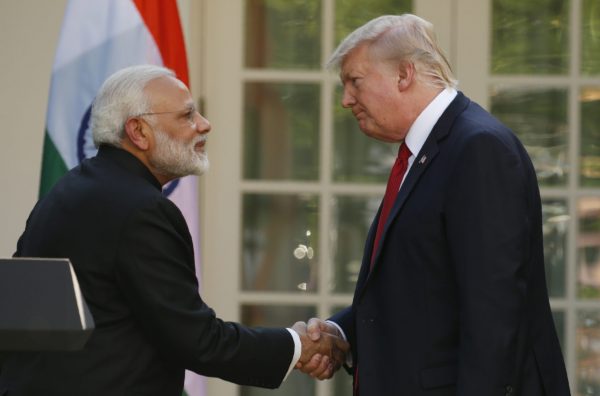No such high-minded adjectives were on hand on 26 June when Prime Minister Narendra Modi paid a brisk ‘no-frills’ visit to the Trump White House.
The tone of the joint statement was business-like and departed from the faintly tribute-bearing language of past statements that had seen India extol America’s virtues in exchange for a steady catalogue of prized bestowals. These include a landmark civil nuclear agreement, support for entry into the Nuclear Suppliers Group, endorsement for a permanent seat in a reformed UN Security Council, conferral of ‘major defence partner’ status and high-end military equipment sales, among others. Whether much, or anything other than defence goodies, remains in Uncle Sam’s sack to dispense in the future will be a pointer of India’s standing and utility in Donald Trump’s worldview.
A notable absence in the joint statement was the lack of a reference to the enduring or indispensable global role of the US–India strategic partnership. This has been a staple of past statements since George W Bush resolved in 2005 to ‘help India become a major world power in the 21st century’. After two illusory vision statements over the past three years, the right-sizing of ambition within the bilateral relationship is both a let-down and past due.
The US–India strategic partnership does not bear global significance because it is basically confined to checking Chinese power in the relative global backwater that is South Asia and the Indian Ocean region (IOR). Washington would prefer to functionally deepen and geographically extend the partnership to cover the Asia-Pacific region; New Delhi, while reciting the paeans of the Indo-Pacific, would prefer to limit that deepening to the IOR. Beyond the waters of the eastern Indian Ocean, the two countries’ worldviews diverge far more frequently than they converge.
The gap between these respective conceptions was on display in the set of three common principles that Trump and Modi laid out for the Indo-Pacific and asked other nations in the region to dutifully observe. Although intended as a barely-concealed rebuke of Chinese behaviour, the principles are hypocritical to say the least, and honoured by India as much in the breach as in their observance.
Trump and Modi reiterated the importance of respecting freedom of navigation, overflight, and commerce throughout the region, yet Washington routinely lists New Delhi as a denier of such freedoms in its Navy’s annual reports. India’s interpretation of user states’ ‘high seas’ navigational rights in its economic exclusive zone and the notification regime in its territorial sea comport closely with China’s — not the United States’.
Trump and Modi called upon their Indo-Pacific counterparts to resolve territorial and maritime disputes peacefully and in accordance with international law. Yet even as Modi spoke, Indian troops were tearing down a road across the Sikkim Himalayan border in a strip of territory that is disputed between China and Bhutan and where New Delhi does not even possess locus standi in the first place to intervene. Washington’s record of adherence to international court awards is not unblemished either.
Trump and Modi cautioned against the use of infrastructure-building and official development financing that fails to respect the sovereignty and territorial integrity of involved third parties — an allusion to China’s belt and road project that traverses Pakistan-administered Kashmir. Yet Obama’s Special Representative for Pakistan and Afghanistan endorsed a large dam project to investors in the very same disputed territory three years ago and New Delhi, for its part, continues to explore hydrocarbon resources with Vietnam in a disputed sector of the South China Sea. From the colour-shading on official maps to the economic development rights of its residents, Washington’s position on Pakistan-administered Kashmir comports closely with Beijing’s — not New Delhi’s.
The remainder of the Trump–Modi interaction was scripted along lines that are emerging as a pattern with the Trump Administration’s Asia diplomacy. His contempt for the beltway foreign policy establishment notwithstanding, Trump appears perfectly at ease in endorsing the conventional Asia policy markers laid down by his predecessors, particularly in areas of vital interest to visiting allies (Japan’s Abe) and partners (Vietnam’s Phuc), so long as they do not conflict with his mercantilist trade and employment policy objectives. Pakistan was singled out as a base for the launch of terror attacks, a Kashmiri militant added to the US Treasury’s specially designated global terrorist list, and the approval for sale of a sophisticated naval drone was thrown-in for good measure.
The India brand has enjoyed a charmed existence for a decade-and-half within Washington policy circles. It is not a given however that past will be prologue. Trump and Modi did not establish any distinguishing format to institutionalise their macroeconomic, trade, infrastructure, energy or law enforcement dialogues, unlike the cases of China’s Xi and Japan’s Abe at Mar-a-Lago. New Delhi’s assistance was by-and-large unsolicited on the burning global issues of the day. And it is not flattering either that the White House’s trusted emissary-to-be in New Delhi, Kenneth Juster, recently lost the trust of his White House superiors and is being relieved of his position as Trump’s G20 sherpa.
Donald Trump may be gone in four years but the structural and socio-economic forces that elevated his protectionist and self-absorbed ‘America First’ vision are here to stay — for years, if not decades. In its dealings with the US, New Delhi must think just as hard what it can bring to the table as it can extract from the table, including burden-share on some of Washington’s pressing non-China-centric global and regional challenges. The tribute-bearing model must evolve into a model of one among equals. Modi’s ‘no frills’ visit was a modest start in this regard.
Sourabh Gupta is a senior Asia-Pacific international relations policy specialist at the Institute for China–America Studies (ICAS) in Washington, D.C.

